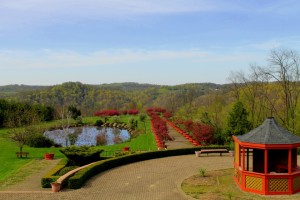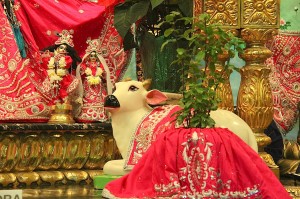An Interview with Krsna dasi from England
Dec. 20, 2013
Lilasuka dasi: Krsna dasi, what made you think of coming to New Vrindaban?
Krsna dasi: Many reasons, really. But the main reason was that New Vrindaban was a very dear project to Srila Prabhupada. If I was going to go anywhere outside of my home country, it’s New Vrindaban because it was so dear to Srila Prabhupada. Actually, I saw an advertisement online in January this year from Jaya Krsna inviting people to come to New Vrindaban. I was working at the time, so I couldn’t go right away. But I did come here as soon as I got a chance. New Vrindaban is a major historic project for ISKCON – the perfect place to spend some time.
LD: There are parts of New Vrindaban’s past history that aren’t so pleasant. Did you know about this and did you decide to come anyways?
KD: Yes, I knew some of the history and had heard bits of things, but I deliberately didn’t catch up on it. I wanted to experience New Vrindaban as it is today, first-hand. I didn’t care to know about the history.
LD: What was the actual impetus that made you finally decide to come?
KD: I replied to Jaya Krsna that I’d like to come and volunteer for a few weeks for whatever was needed. I told him that I could do things like office work, or cooking. He replied, “Yes! Sure! Please come!”
LD: So you’re had some experience cooking for Krsna?
KD: Yes. I cooked back home in 1987. Then, from 1987 to 2000, I used to cook at the Sunday feast at whatever temple I was visiting. I had visited many temples in Europe. After I came to New Vrindaban, I got to cook for a Sunday feast once. I think it’s great when a Sunday feast has lots of sweets, so I cooked sweets for the feast. I like to bake.
LD: What do you like about New Vrindaban?
KD: Wow! That’s a big question. The first thing is that New Vrindaban is an old ISKCON project that Srila Prabhupada really wanted. This is important to me. Also, there are lots of older devotees from the early days that stuck with New Vrindaban. That’s inspirational. Finally, everywhere you go in America, you pretty much know that you’re in America. But here, it is a world apart. And everything you need to live is here! At least, that’s my experience. You don’t even have to leave once you’re here.
Also, we can have the association of all different kinds of devotees, with different backgrounds and experiences. In the summer time, especially, lots of young, enthusiastic devotees come and stay for a while and serve. New Vrindaban is really vibrant. There’s a great morning program with a lot of devotees attending. I mean, compared to some temples where I’ve been, sometimes there are only one or two devotees attending, and if you are not a singer, it’s very difficult.
LD: Tell me more. I’m getting enlivened just listening to you!
KD: Well, there’s a real sense of community here. One thing is that so many devotees take breakfast and lunch together, which reminds me of the old days. It’s really nice.
It’s a busy place where everyone is always busy with so much service to do. When you see that everyone is engaged either in pujari work, cooking, gardening, wood chopping, the restaurant, the lodge, whatever – it’s encouraging.
I also like the way the kitchen is set up, with all stainless steel. Obviously it needs a bit of work, but it’s easy to cook in and I love the big double ovens. It works! I love the scenery in New Vrindaban. I’ve always loved walking. At home, I walk six and a half miles to work every day, which takes about one hour and 10 minutes. So I love going for long walks here too.
LD: I understand you’re leaving in a few days. Are you planning to come back?
KD: If I’m allowed! I would like to. I love it here. I’ve always felt welcome. The devotees look after me and the ashram is quite comfortable.
LD: You make New Vrindaban sound like Utopia!
KD: Well, I especially like the service I do when I come here. A person can get engaged in their own propensity. It’s such a big place so no matter what you like to do, there’s something here for you. As a matter of fact, I have thought of services for some of my friends if they would ever come here. I know exactly where they’d fit in. I’ve also asked my son and daughter to come here. They’d love it.
LD: Thank you very much, Krishna dasi.

Beautiful autumn scenery at New Vrindaban




 KD: I replied to Jaya Krsna that I’d like to come and volunteer for a few weeks for whatever was needed. I told him that I could do things like office work, or cooking. He replied, “Yes! Sure! Please come!”
KD: I replied to Jaya Krsna that I’d like to come and volunteer for a few weeks for whatever was needed. I told him that I could do things like office work, or cooking. He replied, “Yes! Sure! Please come!”  Govardhan retreat with Bhakti Caitanya Swami
Govardhan retreat with Bhakti Caitanya Swami  In the Fall 2013, ISKCON News Website called out to Krishna devotee videographers to send their short videos of inspiring Krishna-conscious people, stories, interesting Krishna-conscious projects, events or activities, or their Krishna-conscious music videos.
There were over 50 contestants applied from 14 different countries, and shared their inspiring short films of various subjects, including festivals, spiritual retreats, Deity worship, outreach and artistic programs.
In the Fall 2013, ISKCON News Website called out to Krishna devotee videographers to send their short videos of inspiring Krishna-conscious people, stories, interesting Krishna-conscious projects, events or activities, or their Krishna-conscious music videos.
There were over 50 contestants applied from 14 different countries, and shared their inspiring short films of various subjects, including festivals, spiritual retreats, Deity worship, outreach and artistic programs.  Video Invitation For Shivaji Park Rath Yatra 2014
Video Invitation For Shivaji Park Rath Yatra 2014 
 Indradyumna Swami: My doctor advised me to start exercising by taking short walks. So taking my camera I went with a small group of devotees by taxi to Radha Kunda and walked two times around the sacred lake. It took 30 minutes. By following the doctors orders hopefully my health improved and surely I got unlimited spiritual benefit. All glories to Sri Radha Kunda! So happy to be back in Sri Vrindavan dhama
Indradyumna Swami: My doctor advised me to start exercising by taking short walks. So taking my camera I went with a small group of devotees by taxi to Radha Kunda and walked two times around the sacred lake. It took 30 minutes. By following the doctors orders hopefully my health improved and surely I got unlimited spiritual benefit. All glories to Sri Radha Kunda! So happy to be back in Sri Vrindavan dhama  Tomorrow, Saphala Ekadasi, is the second anniversary of Yamuna Devi’s departure from this world. Some years ago, she wrote me, “I remember when Dina and I visited you in your house in Vrindavan. We asked you one question, and you took three hours to answer it!
Tomorrow, Saphala Ekadasi, is the second anniversary of Yamuna Devi’s departure from this world. Some years ago, she wrote me, “I remember when Dina and I visited you in your house in Vrindavan. We asked you one question, and you took three hours to answer it!  After three military tours in Vietnam as a photographic interpreter, Shanka das returned to his hometown in Worcester, Massachusetts in 1969. Sometime later, his brother, who was living at the Boston Temple, gifted him a Krishna Book and four pictures of Visnu
After three military tours in Vietnam as a photographic interpreter, Shanka das returned to his hometown in Worcester, Massachusetts in 1969. Sometime later, his brother, who was living at the Boston Temple, gifted him a Krishna Book and four pictures of Visnu  Devotees try to make their mridanga sound be heard even better!
Devotees try to make their mridanga sound be heard even better! 
